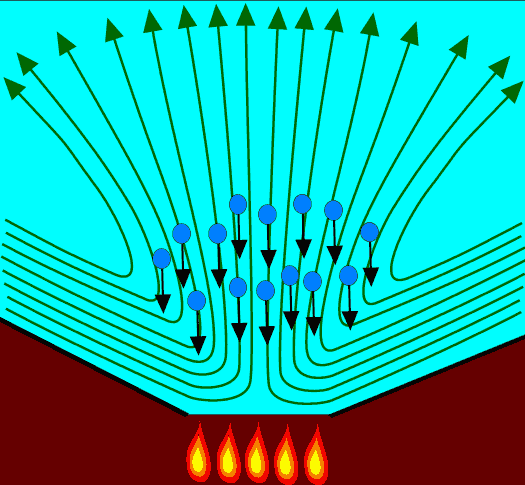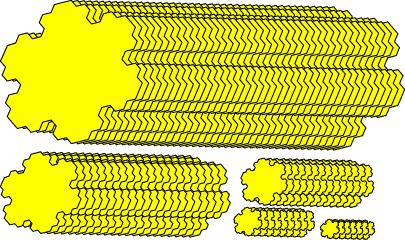

LocationIntroductionThis essay attempts to identify the most probable location for the origin of life.The origin happened too long ago for us to know with any certainty exact details about where it happened. However constraints on the conditions which must have been present when the first organisms formed may allow us to identify some of the characteristics of the environment at that time. Presentation of specific scenarios for the origin of life Should help clarify researchers' thoughts on the subject - and hopefully will assist with the process of recreating the conditions present at the time - to allow the origin to be recreated a modern times.
CluesThe first clue we shall consider comes from the necessity for high-fidelity reproduction of the genomes of the first organisms.Following that of the suggestion of a A G Cairns-Smith - that the first organisms consisted of clay mineral crystals - one requirement is that growth should take place in an environment where the growing crystals may extend themselves without obstruction - and where new crystals should not be able to seed themselves too easily. The presence of "edges" causes problems in this area - because boundary irregularities can act as seeds for the growth of new crystals - and because boundaries to trap existing crystals in an environment where they can grow into each other. Another clue comes from the need for selection favouring organisms of large size. Without such selection, evolution is likely to run into a low complexity ceiling. Details of the requirements imposed by this type of selection are covered in an essay on the topic of selection for large size. That essay identifies gravity as a likely selective agent - and suggests the need for a thermal up-draught in order to create an environment where organisms are continuously falling.
EdenThese clues allow us to speculate to on the nature of environment in which the first organisms are most likely to have formed.The environment in question is in open water - in a thermal updraught above ocean-floor vulcanism. Subduction zones represent a candidate environment which is relatively stable. They also form a continuous planet-wide network. At this stage, a diagram should help:
 Organisms suspended in convection current above subduction zone Such an environment suspends organisms far from the ocean floor. There, crystal growth can occur without obstruction - and is positioned far away from sources of noise. The thermal updraught created by the ocean floor volcanism creates an environment where gravity selection can act - and thus where the smallest organisms are not always the most successful ones - an important requirement if evolution is ever going to get anywhere beyond the "grey goo" level.
Size heirarchy Crystal organisms control their size via their cross-section Crystal organisms can control their size by controlling their cross-section (which is inherited). Crystals with a large cross sectional area are longer - as well as fatter - because their wider cross section makes them stronger, and harder to break. Large organisms consist of a much larger number of units - and would consequently grow and reproduce a lot more slowly than small organisms. Organisms of different sizes are successful at different locations in the convection cell: Small organisms are unable to resist much of a thermal updraught and are pushed to positions where the upward convection forces are weak. Large organisms can use gravity to resist the draught - and adopt a stable position at locations where the thermal updraught is stronger.
ObjectionsAn open water scenario for the origin of life is unorthodox these days - many researchers have either followed Wächtershäuser in considering a 2D origin - [on mineral surfaces] - or have adopted a "warm pond" model - where evaporation can be invoked to explain high concentrations of organic matter.To speculate on the reasons for this, there are some disadvantages when reconstructing the origin of life in such a location - and these difficulties may have put off other researchers. One observation is that living organisms require an energy source. Many other origin-of-life models place the origin in a location Where energy is available from either chemical reactions, or from sunlight. The model described here uses potential energy present in super-saturated solutions as the source of energy for the organisms involved. This energy ultimately comes from the sun. Sunshine casues water to evaporate. The water falls as rain, which erodes the rocks, which makes rivers, which form silt which runs into the ocean, which forms a super-saturated solution, which then makes crystals. Another possible objection is that a location which are surrounded entirely by water is too boring to support living organisms. Organisms require strong selection pressures - in order to prevent their genomes from suffering from catastrophes. I don't believe this criticism it is particularly serious. The gravity-based selection present in this model shows one possible source of selection. The essay referenced at the bottom of this page presents another. The association between this scenairo and under-sea vulcanism creates considerable scope for selection pressures based on interactions between the organisms and organic chemicals in their environment.
RequirementsThis scenario requires the presence of liquid water oceans and vulcanism.It seems likely that these conditions were present on the early Earth - as well as on Mars early in its history.
Subsequent developmentsThe scenario described here also suggests how the first organic material might have been used by early organisms.An essay about the first organic matter used by organisms is available here.
|